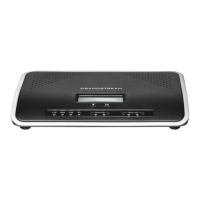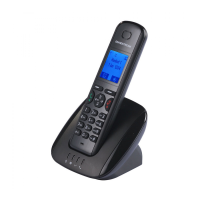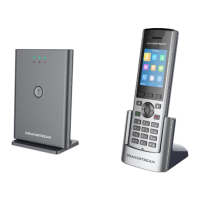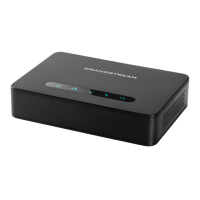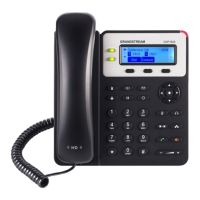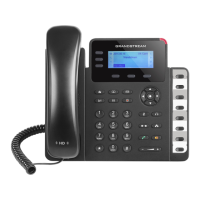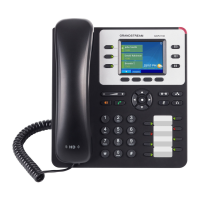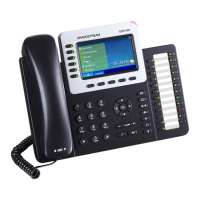Do you have a question about the Grandstream Networks UCM6206 and is the answer not in the manual?
| Brand | Grandstream Networks |
|---|---|
| Model | UCM6206 |
| Category | IP Phone |
| Language | English |
Details significant changes across firmware versions, focusing on new features and major updates.
Lists the detailed technical specifications of the UCM6200 series, covering interfaces, codecs, protocols, and physical attributes.
Describes the hardware interfaces, voice/video capabilities, signaling protocols, and security features of the UCM6200.
Highlights features like multi-language support, caller ID, call center, and maximum call capacity.
Lists the items included in the UCM6200 package, such as the main unit, power adapter, and cables.
Provides step-by-step instructions for connecting the UCM6202, UCM6204, and UCM6208 devices.
Details safety compliances, warranty policy, and important warnings regarding power adapters for the UCM6200.
Explains how to use the LCD menu, LED indicators, and Web GUI for device configuration and operation.
Guides users on how to access the UCM6200's Web GUI through a web browser for configuration.
Describes the initial setup wizard and how to configure Web GUI languages for user convenience.
Explains how to save configurations and guides users through making their first call with the UCM6200.
Covers user management, creating accounts, defining privileges, and accessing the user portal for system administration.
Details network settings including basic configuration, 802.1X, static routes, port forwarding, OpenVPN, and DDNS.
Explains firewall configurations, static and dynamic defense, and Fail2ban for system security and intrusion prevention.
Covers configuring LDAP server, HTTP server, and email settings for notifications and fax delivery.
Details time settings, NTP server configuration, and managing recording storage for calls and other data.
Covers login timeout settings, Google service integration, and monitoring system events and alerts for system health.
Introduces the Zero Config feature for automated provisioning of Grandstream SIP devices via web interface or configuration files.
Explains the layered configuration architecture and the three methods for auto-provisioning SIP devices.
Details configuring global policies, model templates, and device-specific settings for endpoint provisioning.
Covers creating, managing, and updating device configurations and model templates for endpoint provisioning.
Guides on creating new SIP, IAX, and FXS extensions, detailing their configuration parameters.
Explains how to batch add SIP and IAX extensions for efficient bulk configuration.
Covers managing extensions, exporting/importing configurations, emailing user details, and enabling multiple registrations.
Describes the built-in SIP SMS message support for Grandstream GXP/GXV phones.
Details the configuration parameters for analog trunks, including channels, SLA mode, and polarity.
Explains how to use PSTN detection to identify busy tones, polarity reversal, and current disconnect.
Covers configuring VoIP trunks, including SIP peer and register trunks, and IAX trunks for external connectivity.
Explains the Direct Outward Dialing (DOD) service for connecting subscribers to outside lines directly with specific caller ID.
Details how to configure SLA stations to map phone keys to external lines for monitoring analog trunk status.
Provides a practical example of configuring SLA stations and MPK settings for monitoring analog trunks.
Explains how to configure outbound calling rules, patterns, and priorities for dialing through different trunks.
Describes how to configure a blacklist for outbound routes to prevent calls to specific numbers or patterns.
Details configuring inbound routes, DID patterns, and default destinations for incoming calls.
Explains how the UCM6200 automatically detects and routes Fax or phone signals to the correct destination.
Covers enabling and managing the blacklist feature for all inbound routes to block unwanted calls.
Details how to create, edit, and manage conference bridges, including participant management and call recordings.
Explains conference settings, participant controls via web GUI and IVR, and managing active calls.
Guides on enabling and retrieving recorded conference calls, managing recording files.
Covers creating, editing, and viewing scheduled conferences, including synchronization with Google Calendar.
Details options for automatically cleaning up scheduled conference data based on configured time intervals.
Explains how to create, edit, and delete IVR configurations, including basic settings and DID destinations.
Details configuring key pressing events, welcome prompts, digit timeouts, and custom prompts for IVR menus.
Describes setting up blacklists and whitelists in IVR to restrict or allow access to specific extensions.
Guides on downloading, installing, and managing voice prompt packages for different languages on the UCM6200.
Explains how to upload and use single custom voice prompts for specific IVR scenarios.
Details configuring voicemail settings like greetings, message limits, effective message time, and caller ID announcements.
Explains how to access voicemail via phone keypad and configure voicemail to email settings for message delivery.
Covers creating and configuring voicemail groups to forward messages to multiple extensions simultaneously.
Details configuring ring groups, including members, ring strategy, and music on hold settings.
Explains how to include remote extensions from a peer UCM6200 in ring groups using SIP peer trunks and LDAP sync.
Covers configuring paging and intercom groups for broadcasting announcements to multiple phones simultaneously.
Details setting up call queues with various strategies, music on hold, and agent management for efficient call distribution.
Explains configuring agent login/logout settings and managing queue recordings for performance analysis.
Covers creating and using extension groups for better management and applying configurations like source caller ID filtering.
Details setting up pickup groups to allow extensions to answer calls for other members within the same group.
Explains how to configure the feature code used for picking up calls within a pickup group.
Covers configuring music on hold classes and uploading/managing audio files for playing music during calls.
Details configuring fax settings, including error correction, transfer rates, and fax mode for T.30/T.38 support.
Provides sample configurations for receiving faxes from PSTN lines and sending faxes to email addresses.
Explains Asterisk Manager Interface (AMI) access, configuration, and crucial security warnings for untrusted networks.
Describes the busy camp-on/call completion feature for informing callers when a called party becomes available.
Guides on setting up the Follow Me feature to direct calls to multiple numbers or devices for user availability.
Details setting up system-wide speed dial access using one or two digits on the keypad for quick dialing.
Explains Direct Inward System Access (DISA) for users to access PBX resources and dial out from external locations.
Describes the callback feature for reducing long-distance call costs by routing calls through the PBX.
Explains how to configure BLF for monitoring extensions, ring groups, call queues, and parking lots.
Details setting up event lists to monitor local and remote extensions' status via web GUI or SIP trunks.
Covers creating Dial by Name directories and configuring search types for easy contact lookup via phone keypad.
Explains the three methods for setting up WakeUp Service: using admin login, user portal, or feature code.
Describes how to monitor active calls, view status, hang up calls, and use call monitoring features like listen, whisper, and barge.
Lists and explains various call feature codes for blind transfer, attended transfer, call park, DND, call forward, and more.
Details configuring Do Not Disturb (DND), Call Forward Busy, Call Forward No Answer, and Call Forward Unconditional.
Explains call park, retrieve parked calls, and monitoring features like Listen Spy, Whisper Spy, and Barge Spy.
Covers general system preferences and extension settings like password enforcement and extension ranges.
Details managing custom prompts, configuring jitter buffer, RTP settings, payload types, and PIN groups.
Covers general IAX settings like bind address and compatibility, and registration options like expiry and thread count.
Details IAX static defense settings for IP addresses and trunk options like frequency and time stamps.
Covers general SIP settings such as realm, UDP port, IP address binding, and guest call handling.
Details SIP session timer modes, TCP/TLS enabling, and certificate management for secure connections.
Explains SIP NAT settings for handling IP addresses behind NAT and ToS settings for packet prioritization.
Covers FXS port signaling preferences and FXO port ACIM settings, including tone region selection.
Details advanced FXO and FXS opermode settings, TISS override, PCMA override, and ring detection.
Describes fax sending via web UI and the Announcements Center feature for pre-recorded voice messages to groups.
Covers configuring groups and assigning custom prompts for the Announcements Center feature.
Lists PMS features supported by Mitel/HMobile and details basic settings for connecting to the HMobile platform.
Covers creating and managing rooms, viewing room status, and configuring PMS wake-up services.
Explains the configuration of Mini Bar services and consumer goods billing features within the PMS module.
Details configuring SugarCRM integration, including server address and contact lookup settings.
Covers configuring Salesforce CRM integration, including user credentials and security token setup.
Provides an overview of monitoring PBX status for trunks, extensions, queues, conference rooms, interfaces, and parking lots.
Details monitoring system status, including general hardware/software info, network, storage, and resource usage.
Covers monitoring system events, configuring alert lists, viewing alert logs, and setting up alert contacts for notifications.
Explains Call Detail Records (CDR), filtering reports, viewing call details, and downloading CDR files.
Details CDR statistics for call analysis and managing recorded call files via the web GUI.
Covers enabling API access, configuring TLS settings, authentication, and permitted IP addresses for third-party integration.
Explains methods for upgrading firmware via network (TFTP/HTTP/HTTPS) or local upload from a PC.
Covers backing up and restoring UCM6200 configurations, including data synchronization via SFTP.
Details system maintenance tasks like cleaning CDR/files, resetting the device, and rebooting.
Explains configuring syslog for logging and using troubleshooting tools like Ethernet capture, ping, and traceroute.
Covers troubleshooting analog trunk issues using record trace, key dial-up FXO, and service check features.
Details checking network status, managing remote access, and enabling/disabling SSH access for debugging.
